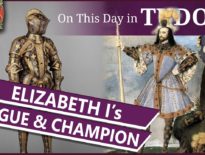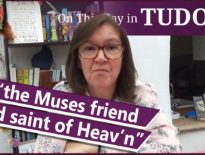On this day in Tudor history, the feast of Childermas, 28th December 1510, lawyer, administrator and Lord Keeper of the Great Seal, Sir Nicholas Bacon, was born. Bacon was the father of the famous philosopher, statesman, scientist and author, Sir Francis Bacon.
Bacon wasn't just a lawyer and statesman, he was also very concerned with the education of the young, and did much to support it.
Find out all about Sir Nicholas Bacon, his life and career, and how he was banished from court at one point, in today's talk.
28th December is also Childermas or Holy Innocents' Day, an important part of the Twelve Days of Christmas in Tudor times. In last year’s video, I explained the origin of this feast day and how it was commemorated in the Tudor period.
Also on this day in history:
- 1572 – Death of John Hales, member of Parliament, writer and administrator. He was buried in St Peter-le-Poer Church, Broad Street, London. Hales served as Clerk of the Hanaper, a Justice of the Peace and member of Parliament.
- 1582 – Burial of goldsmith John Mabb at St Matthew Church, Friday Street, off Cheapside in London. Mabb was also Chamberlain of the City of London.
- 1603 – Death of John Joscelin (Joscelyn), clergyman, antiquary and Old English scholar, at High Roding. He was buried at All Saints' Church, High Roding. Joscelin was Latin secretary to Matthew Parker, Archbishop of Canterbury, and is known for his Old English-Latin dictionary and the work he did for Parker in discovering and publishing lost manuscripts.
Transcript:
On this day in Tudor history, the feast of Childermas, 28th December 1510, lawyer, administrator and Lord Keeper of the Great Seal in Elizabeth I's reign, Sir Nicholas Bacon, was born. Bacon was the father of the famous philosopher, statesman, scientist and author, Sir Francis Bacon.
Let me tell you more about this Tudor man…
• Sir Nicholas Bacon was probably born at Drinkstone in Suffolk, and was the second son of Robert Bacon, yeoman and sheep-reeve (chief shepherd), and his wife Isabel Cage.
• Bacon was educated at Bury St Edmunds Grammar School and then Corpus Christi College, Cambridge, where he met men like Matthew Parker, future Archbishop of Canterbury, and future Protestant martyr Thomas Dusgate.
• By 1532, he had been admitted to Gray’s Inn, one of London’s inns of the court, and in the same year became a barrister.
• By 1538, Bacon was serving in the court of augmentations, the court that had been set up to deal with monastic property and revenue confiscated during the dissolution of the monasteries. By 1540, he was serving as the solicitor of the augmentations.
• Bacon benefited from the dissolution of the monasteries by being granted former monastic properties as rewards and also buying dissolved monasteries and land, particularly in and around Suffolk.
• In 1540, Bacon married Jane Ferneley, daughter of a yeoman from Suffolk. The couple went on to have six surviving children. Jane’s sister was married to Thomas Gresham, the well-known financier and merchant who founded the Royal Exchange.
• By 1542, Bacon was serving as a Member of Parliament for Westmorland, then in 1545 for Dartmouth.
• In 1546, Bacon became attorney to the court of wards and liveries, a position which fit with his interest in education for the young.
• Sadly, Jane died in 1552 and just months later Bacon married Anne Cooke, daughter of scholar Sir Anthony Cooke, and sister of Katherine Killigrew, the lady I talked about yesterday, and also Mildred Cecil and Elizabeth Russell. They had two sons, Anthony and Francis.
• In 1560, Bacon purchased the manor of Gorhambury in Hertfordshire and built a mansion on the site.
• In 1561, he wrote a paper, “Articles devised for the bringing up … of the queen's majesty's wards”, and he made sure that all five of his sons were well educated. He also founded several grammar schools, donated books to Cambridge, and established scholarships.
• In the summer of 1553, during the succession crisis, Bacon’s wife, who had been in Mary’s service, pledged her allegiance to Mary I, and although they were Protestants, Anne’s husband and her brother-in-law, William Cecil, were able to make their peace with the Catholic queen. Anne Bacon continued in Mary’s service as a gentlewoman of the privy chamber despite her and her husband’s Protestant faith.
• Bacon survived Mary’s reign by focusing on his duties at the court of wards and Gray’s Inn, but things changed for the better when Elizabeth I came to the throne in November 1558. The new queen sought Bacon’s advice on forming her government and he was able to help her persuade his friend, Matthew Parker, to serve as her Archbishop of Canterbury, even though Parker did not want to.
• In December 1558, Elizabeth knighted Bacon, made him a privy councillor and Lord Keeper of the Great Seal, which was Lord Chancellor in all but name. In that role, he opened the queen’s first parliament in 1559, giving an opening speech in which he called for moderation and tolerance with regards to religion.
• In 1563, he incurred Elizabeth I’s wrath after helping John Hales to gather information and opinion on the case for Lady Katherine Grey being Elizabeth’s closest heir to the throne. Hales published “A Declaration of the Succession of the Crowne Imperial of Ingland”, and Bacon was temporarily banished from court and from the privy council, but thanks to the help of his brother-in-law, Cecil, he managed to get back into favour in 1565.
• In 1568, the queen appointed Bacon to preside over the Westminster conference looking into whether Mary, Queen of Scots, was involved in the murder of her second husband, Lord Darnley. In 1569, he was chosen to investigated the Rising of the North and those involved, and then, in 1570, he presided over the York House conference which was about Mary, Queen of Scots. He was against released the imprisoned Scottish queen.
• Bacon was a staunch Protestant and in 1568 he was described by the Spanish ambassador as “one of the most pernicious heretics in Europe”, and a tract published abroad called “ A Treatise of Treasons againste Queen Elizabeth and the Crowne of England” attacked him and his colleague and brother-in-law, William Cecil.
• Bacon and his wife, Anne, harboured Puritans at their manor of Gorhambury and Matthew Parker reprimanded him for being lenient towards Puritans, but not Catholics, and for maintaining a preacher who encouraged prophesying.
• In 1577, Bacon played host to the queen on her four-day visit to Gorhambury.
• Bacon died in London on 20th February 1579, probably from pneumonia, and was laid to rest at St Paul’s. In his will, he left £200 for the building of a new chapel at Corpus Christi.
• As well as being a loyal crown servant, Bacon was a patron to writers and scientists, a keen builder, a keen humanist and student of classical literature, a man who assembled a fine library, and a poet. He was also a real family man, something which is evident in his letters and a poem he wrote for his wife, Anne, when she was ill.



Leave a Reply